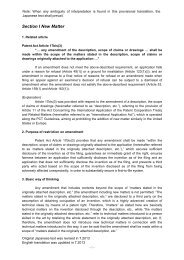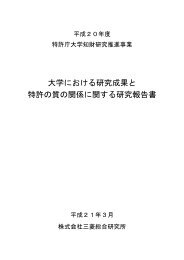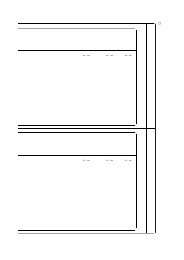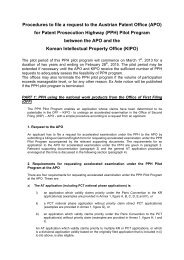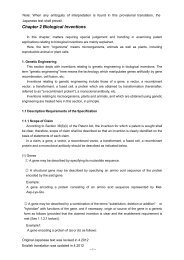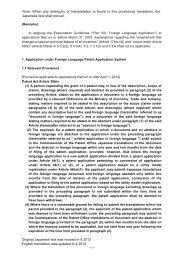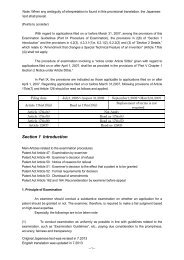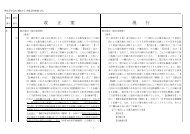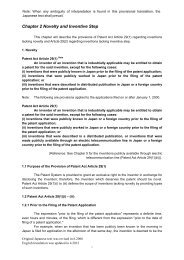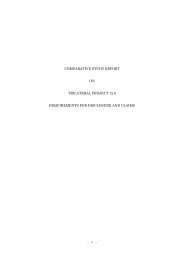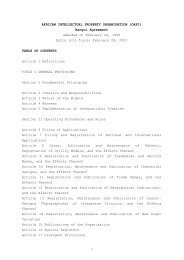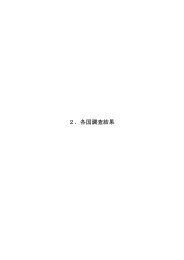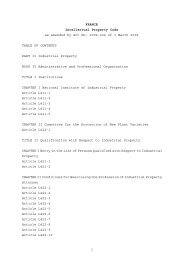Requirements for Unity of Application - Japan Patent Office
Requirements for Unity of Application - Japan Patent Office
Requirements for Unity of Application - Japan Patent Office
Create successful ePaper yourself
Turn your PDF publications into a flip-book with our unique Google optimized e-Paper software.
Electroconductive ceramic composed <strong>of</strong> silicone nitride and titanium nitride.<br />
Both inventions belong to the technical field <strong>of</strong> electroconductive ceramics, and hence<br />
share the same industrial field <strong>of</strong> application. The problems to be solved by the inventions<br />
are also the same, as explained in 1.1.2 (Example 6). The two inventions there<strong>for</strong>e satisfy<br />
the conditions prescribed under <strong>Patent</strong> Law section 37(i).<br />
(Example 9)<br />
Specified invention:<br />
Transmitter provided with time axis expander <strong>for</strong> video signals.<br />
Related invention:<br />
Receiver provided with time axis compressor <strong>for</strong> video signals received.<br />
Related invention:<br />
Transmission equipments <strong>for</strong> video signals comprising a transmitter provided with time axis<br />
expander <strong>for</strong> video signals and a receiver provided with time axis compressor <strong>for</strong> video<br />
signals received.<br />
The inventions <strong>of</strong> this example constitute so-called subcombinations and<br />
combination.“ Subcombinations” refer to inventions <strong>of</strong> equipments or subprocesses, which<br />
when combined, make up inventions <strong>of</strong> combined equipments comprising combinations <strong>of</strong><br />
two or more equipments, or combined processes comprising combinations <strong>of</strong> two or more<br />
subprocesses (hereafter referred to as “combinations”).<br />
In this example, the specified invention relates to the technical field <strong>of</strong> transmitters <strong>for</strong><br />
video signals, while the related inventions each relate to technical fields <strong>of</strong> receivers <strong>for</strong><br />
video signals and transmission equipments <strong>for</strong> video signals. It is considered that<br />
combination <strong>of</strong> technology in the field <strong>of</strong> transmitters <strong>for</strong> video signals with technology in the<br />
field <strong>of</strong> receivers <strong>for</strong> video signals, or application <strong>of</strong> said technology to the field <strong>of</strong><br />
transmission equipments <strong>for</strong> video signals, is quite appropriate, and that the industrial fields<br />
<strong>of</strong> application <strong>for</strong> these inventions are there<strong>for</strong>e the same. Meanwhile, the problem to be<br />
solved by these inventions is common, which lies in enabling transmission <strong>of</strong> video signals<br />
through a narrow frequency band. The three inventions there<strong>for</strong>e satisfy the conditions<br />
prescribed under <strong>Patent</strong> Law section 37(i). According to the concept described above, the<br />
requirement <strong>of</strong> <strong>Patent</strong> Law section 37(i) would still be met even in the absence <strong>of</strong> the<br />
combination claim.<br />
1.2 Relationship under Section 37(ii)<br />
<strong>Patent</strong> Law section 37(ii) provides <strong>for</strong> unity <strong>of</strong> application between specified and related<br />
inventions <strong>for</strong> which the industrial fields <strong>of</strong> application and the substantial parts <strong>of</strong> the<br />
matters defining the inventions are both the same. Specified and related inventions falling<br />
under this relationship must be expressed in the same category, i.e. “product and product” or<br />
“process and process.”<br />
1.2.1 Same Industrial Field <strong>of</strong> <strong>Application</strong><br />
The determination <strong>for</strong> identity <strong>of</strong> industrial fields <strong>of</strong> application is similar to that described<br />
in “the relationship under Section 37(i) (refer to 1.1.1).”<br />
1.2.2 Same Substantial Parts <strong>of</strong> Matters defining Inventions<br />
The substantial parts <strong>of</strong> the matters defining the inventions in claims refer to new<br />
matter corresponding to the problems to be solved by the invention. “Same substantial parts<br />
<strong>of</strong> the matters defining the inventions in the claims” refers to cases wherein the specified<br />
7



